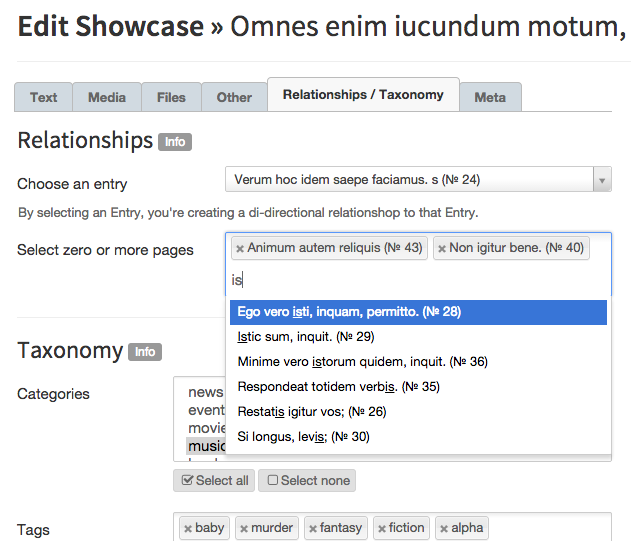ContentTypes / Relationships
Note: You are currently reading the documentation for Bolt 3.7. Looking for the documentation for Bolt 5.2 instead?
You can define relationships between records by adding a relation to
contenttypes.yml.
entries:
name: Entries
singular_name: Entry
fields:
[..]
relations:
pages:
multiple: false
label: Select a page
order: -id
[..]The relations are defined by the slug of the ContentType that it's related to.
In the example above pages. It takes a few parameters:
| Parameter | Description |
|---|---|
multiple |
true or false, to indicate whether the user can pick one related record, or more than one. |
label |
The label to show on the edit screen. |
order |
The order in which the items are listed on the edit screen. This can be any field in the ContentType. Prefix with - to reverse the sorting. In the case of the example, -id means that the records that were created last are at the top. |
format |
How to show the titles for each record that can be selected. This takes a twig string where item is the record that can be selected. For example if you have two fields for firstname and lastname you might put '{{item.firstname}} {{item.lastname}}' here. The default is '{{ item.title|escape }} (№ {{ item.id }})' |
Editing a record that has relations defined looks like this:
If you define a relation only one way, for example from entries to pages,
but not the other way around, you will still see the references when editing the
record that has a relation to another record. It looks like this:
If you see this, you might consider adding the reverse relation to the
contenttypes.yml as well.
Relations in templates¶
Internally, relations are stored and accessible in the Bolt\Record object.
However, accessing record.relation will give you nothing but the ContentTypes
and id's:
{{ dump(record.relation) }}Output:
arr(2)
[
"pages" => arr(1)
[
0 => str(2) "45"
]
"kitchensinks" => arr(2)
[
0 => str(2) "12"
1 => str(2) "23"
]
]To get the actual related records, use the function related()
{% set relatedrecords = record.related() %}
{% if relatedrecords is not empty %}
<p>Related content:</p>
<ul>
{% for related in relatedrecords %}
<li><a href="{{ related.link }}">{{ related.title }}</a></li>
{% endfor %}
</ul>
{% endif %}The related() function has two optional parameters. If you don't pass any
parameters, you will get all related records, regardless of their ContentType.
To retrieve only the related records of a specific ContentType, use:
{% set relatedrecords = record.related('pages') %}To request only one specific related record, pass the id as the second parameter:
{% set relatedrecords = record.related('pages', 45) %}To use pagination in a list of related records, use the ids of the related
records in a setcontent tag:
{% set ids = record.relation.news|join(" || ") %}
{% setcontent messages = "news" where { id: ids } allowpaging limit 6 %}
{% for item in messages %}
...
{% endfor %}
{{ pager('news') }}Note: The related() function
always returns an array of records, even if you request only a single
record. In general, it's best to always use a {% for %}-loop, to
iterate over the results.
Couldn't find what you were looking for? We are happy to help you in the forum, on Slack or on Github.

